I don't remember much from the time when I was in elementary school, but one thing I do remember is when we'd get a quiz that was right off the ditto machine. It was usually slightly damp,with that faded bluish type, and had that strong ditto smell. Dittos seemed so fresh and clean and homemade.
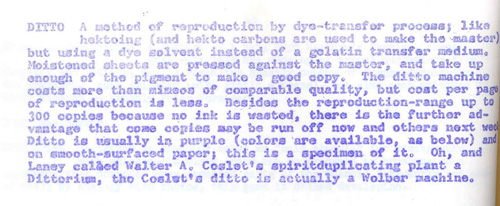
picture from Popthomology
This memory provides a stark contrast to my memory of tests in college, where we used computerized, paper-cut inducing, buy-your-own-and-bring-them-on-test-day scantron sheets.

These are some lilacs that broke off of a nearby lilac tree in a windy rainstorm several weeks ago. I spotted them on the ground and wondered how much I could figure out about lilacs just from observing this one twig. I brought the twig home, put it in some water, and examined it for a while. So, let me tell you some of what I learned about lilac trees....
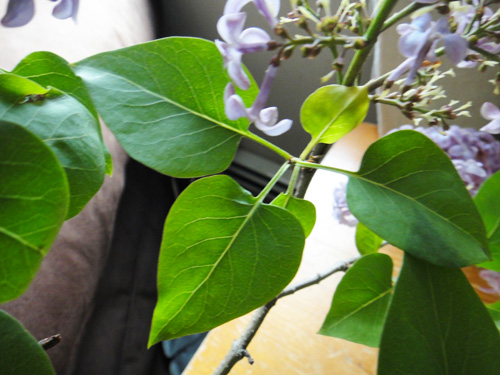
First, let's look at the leaves. The lilac tree has broad leaves (that just means that it has leaves and not needles). They are single leaves (not compound leaves like my ash tree), which are not lobed (like the maple leaf), with smooth margins (unlike the toothed edges of my tree's leaves). They are symmetrical, with an oval shape and pointed tip. The veins branch off the main center vein at different points rather than all branching from the base (as in this leaf from a Japanese maple).
Looking at the way the leaves and flower clusters are growing out from the stem suggests to me that the lilac tree has an opposite branching pattern. There are pairs of leaves growing off the stem from the same spot in opposite directions. The twig, too, seems to have this same pattern, although it is slightly different from the opposite pattern of the ash tree that I've been following.
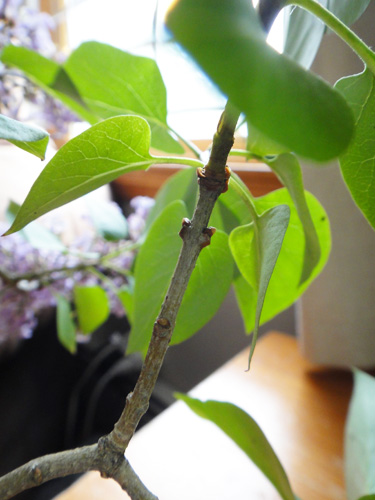
My ash tree always has two opposing stems growing out of one main twig, which continues in the center. It looks like this. But the twigs of the lilac tree seem to often simply split into two opposite branches (as seen at the bottom of the above picture). The picture below shows how one twig ended with two terminal buds which opened up to grow two shoots that held flowers. Notice how the twig does not continue in the center.
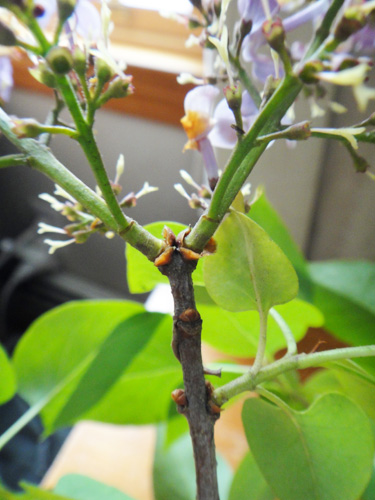
The lilac flowers themselves are, true to their name, a beautiful pale lilac color. They each have four petals and grow in clusters. One flower stem has many pairs of opposite branches that continue up the stem. Each one of these branches produces one or even more flowers. This creates the long oval bundle of flowers that are typical of lilacs. The center of the flower holds the various girl and boy parts. I couldn't get a great close-up, but I'm thinking that the yellow center may be the male pollen-producing parts. If we look closer at the stems where flowers have already fallen off, we see only a long, white structure remaining.
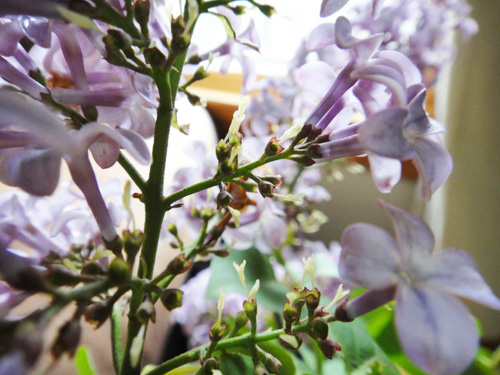
I'm guessing that this is the female part of the flower: the ovary that would produce the fruit. There's no need for the male part of the flower to stick around, so it makes sense that this is the only part the tree would keep. I wonder what the fruit will look like.... UPDATE: I walked past the spot where I found the lilac twig and found some developing fruit on the tree!
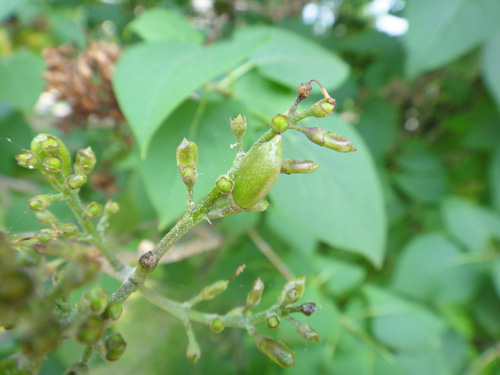
I see one large seed-looking fruit developing. It looks like the long white things have disappeared or shriveled up (see the top middle of the picture) and these little seed things are growing out of the buds now. Fascinating!
Okay, time to check my work! This is a little tough because most tree id keys that I can find online do not include the lilac. This site details the characteristics of the lilac tree's leaves and mentions most of the details I identified along with a few others. And this site describes the main characteristics of the entire lilac tree, including the bark, which I didn't discuss. This page provides a thorough description of the lilac tree which includes many details on the male and female flower structures and the fruit. And even if you don't look at any of those, you MUST check out this page from microscopy-uk that has amazing pictures of all the structures in the lilac flower! Mind blowing!
So, how'd I do?

picture from Popthomology
This memory provides a stark contrast to my memory of tests in college, where we used computerized, paper-cut inducing, buy-your-own-and-bring-them-on-test-day scantron sheets.

This whole stroll down memory lane is really just a way of saying, it's test time on the tree blog! I wanted to come up with an assessment that wasn't about memorizing vocabulary words or choosing the best answer from a group of intentionally similar and tricky choices. Instead, I wanted this assessment to be in keeping with the way I've been learning about trees. And, if possible, I'd like it to smell good.
So here's what I came up with:

So here's what I came up with:

These are some lilacs that broke off of a nearby lilac tree in a windy rainstorm several weeks ago. I spotted them on the ground and wondered how much I could figure out about lilacs just from observing this one twig. I brought the twig home, put it in some water, and examined it for a while. So, let me tell you some of what I learned about lilac trees....

First, let's look at the leaves. The lilac tree has broad leaves (that just means that it has leaves and not needles). They are single leaves (not compound leaves like my ash tree), which are not lobed (like the maple leaf), with smooth margins (unlike the toothed edges of my tree's leaves). They are symmetrical, with an oval shape and pointed tip. The veins branch off the main center vein at different points rather than all branching from the base (as in this leaf from a Japanese maple).
Looking at the way the leaves and flower clusters are growing out from the stem suggests to me that the lilac tree has an opposite branching pattern. There are pairs of leaves growing off the stem from the same spot in opposite directions. The twig, too, seems to have this same pattern, although it is slightly different from the opposite pattern of the ash tree that I've been following.

My ash tree always has two opposing stems growing out of one main twig, which continues in the center. It looks like this. But the twigs of the lilac tree seem to often simply split into two opposite branches (as seen at the bottom of the above picture). The picture below shows how one twig ended with two terminal buds which opened up to grow two shoots that held flowers. Notice how the twig does not continue in the center.

The green stems in this picture however do have a structure more similar to my ash tree, where the center stem continues. I'm thinking that the lilac twigs may split into two just at the tips. Another interesting thing I notice in this picture is that some buds have opened up to produce leaves and some have opened up to grow flowers. The flowers and the leaves do not appear on the same stems. I wonder if only the terminal buds are producing the flowers, while all the lateral (side) buds are producing leaves. I've seen that on some trees in the neighborhood (of course, my ash tree is just the opposite, with the terminal buds only producing the leaves).
Now, let's take a look at those flowers.
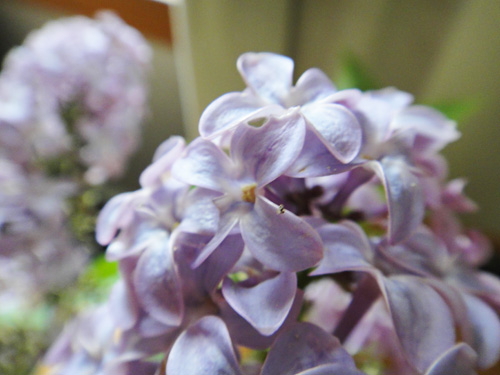
Now, let's take a look at those flowers.

The lilac flowers themselves are, true to their name, a beautiful pale lilac color. They each have four petals and grow in clusters. One flower stem has many pairs of opposite branches that continue up the stem. Each one of these branches produces one or even more flowers. This creates the long oval bundle of flowers that are typical of lilacs. The center of the flower holds the various girl and boy parts. I couldn't get a great close-up, but I'm thinking that the yellow center may be the male pollen-producing parts. If we look closer at the stems where flowers have already fallen off, we see only a long, white structure remaining.

I'm guessing that this is the female part of the flower: the ovary that would produce the fruit. There's no need for the male part of the flower to stick around, so it makes sense that this is the only part the tree would keep. I wonder what the fruit will look like.... UPDATE: I walked past the spot where I found the lilac twig and found some developing fruit on the tree!

I see one large seed-looking fruit developing. It looks like the long white things have disappeared or shriveled up (see the top middle of the picture) and these little seed things are growing out of the buds now. Fascinating!
Okay, time to check my work! This is a little tough because most tree id keys that I can find online do not include the lilac. This site details the characteristics of the lilac tree's leaves and mentions most of the details I identified along with a few others. And this site describes the main characteristics of the entire lilac tree, including the bark, which I didn't discuss. This page provides a thorough description of the lilac tree which includes many details on the male and female flower structures and the fruit. And even if you don't look at any of those, you MUST check out this page from microscopy-uk that has amazing pictures of all the structures in the lilac flower! Mind blowing!
So, how'd I do?
